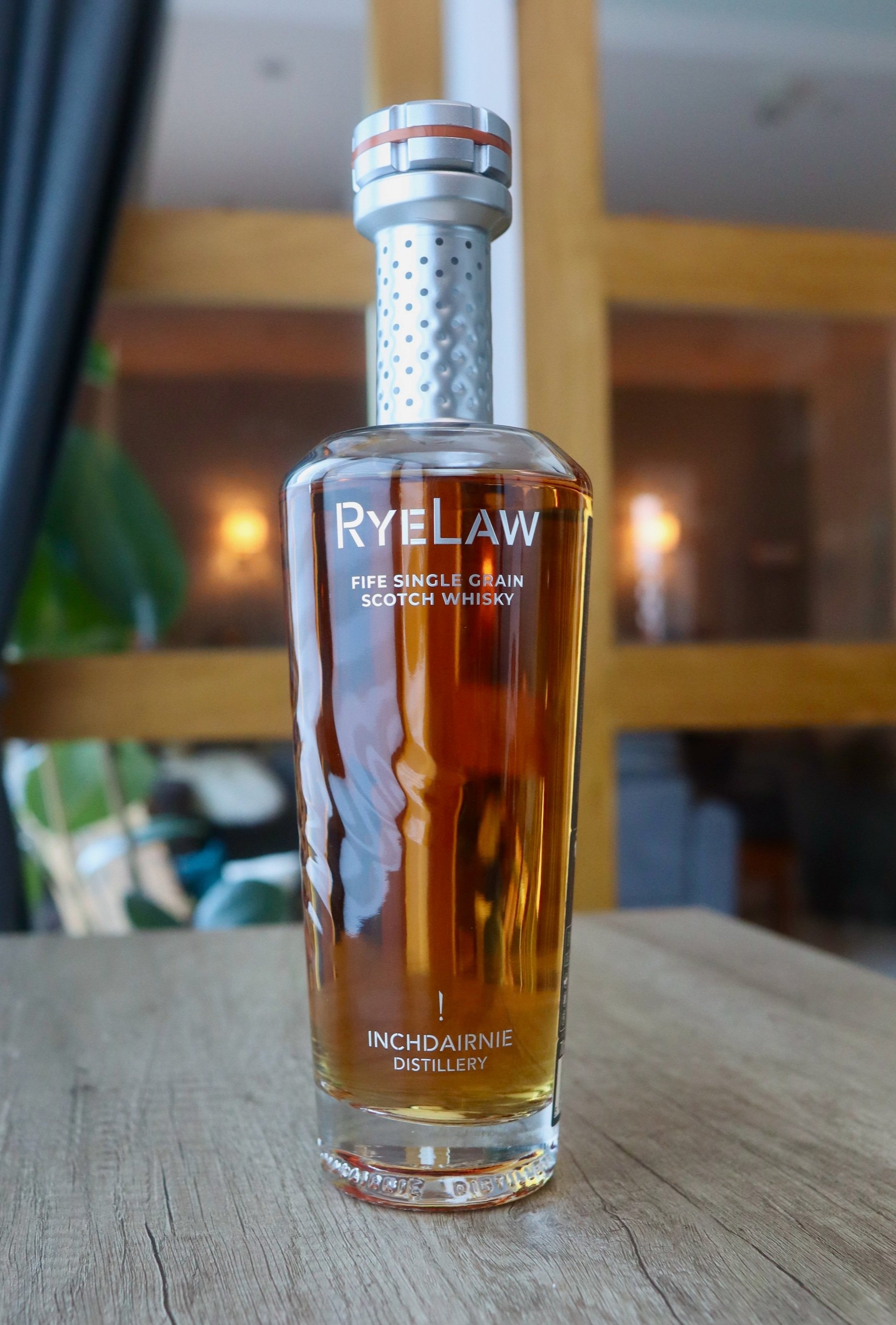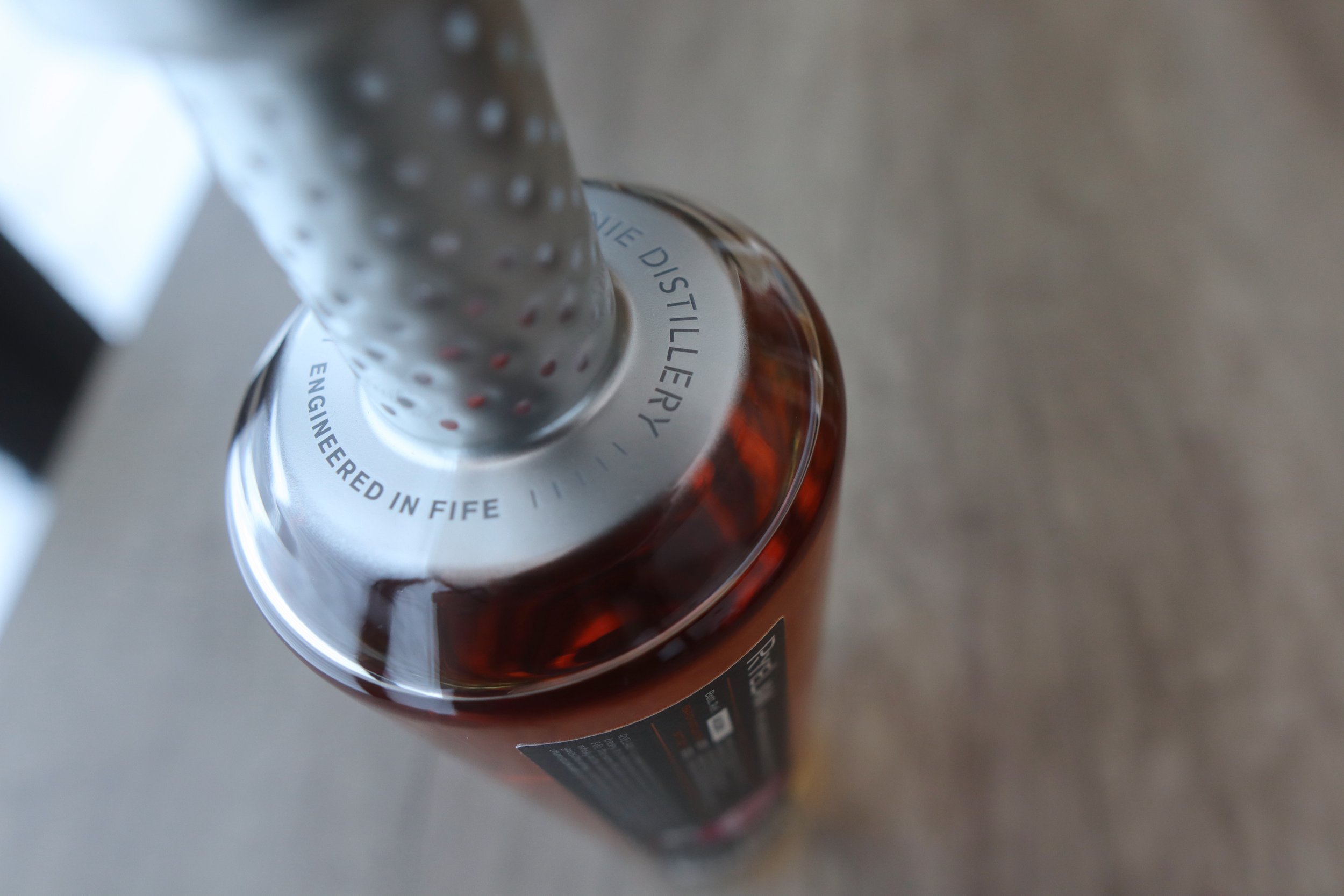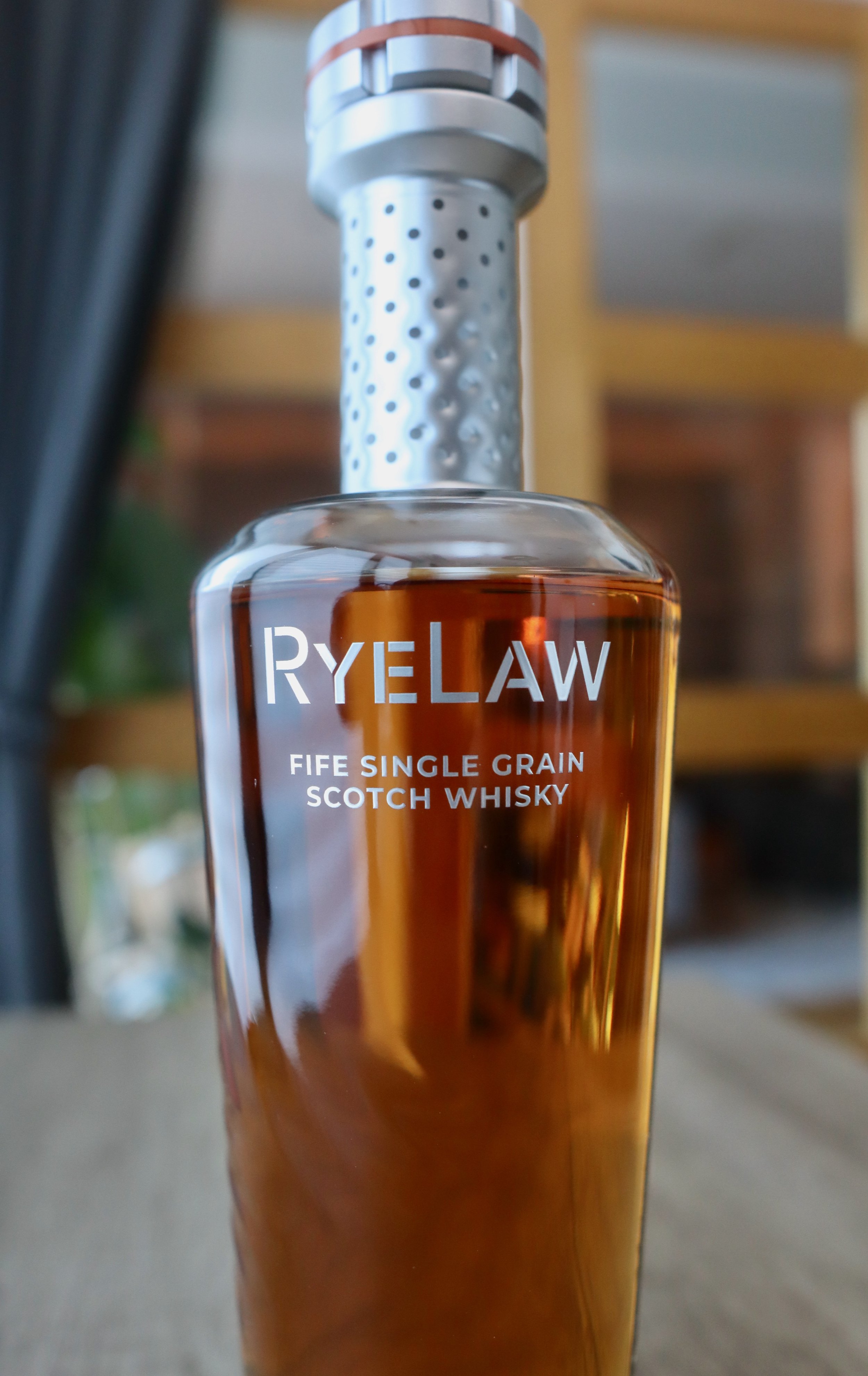InchDairnie RyeLaw
Single Grain Scotch Whisky / Rye & Malt | 46.3% ABV
Score: 7/10
Very Good Indeed.
TL;DR
Expensive, but read on. Please.
Catcher in the Rye
“If a body catch a body comin’ through the rye”, is how Holden Caulfield, the protagonist of J.D. Salinger’s Catcher in the Rye, articulates his angst at not being able to ‘catch them all’. It isn’t exactly true to Robert Burns’ original verse, but his version matches his sentiment and suits the narrative; despite a desire to save them all, some wilfully, haphazardly or accidentally leave the rye field, only to fall from the cliff.
Rye gets a hard time around Dramface towers. Largely thanks to our charismatic but famously stubborn podcast host, Gregor, rye has long been denounced, time and again, as the ‘devil’s grain’.
This is harsh, but understandable. We’re mostly cruising in the scotch whisky lane here and, in a very general sense, I think rye is easier if you come at it from a bourbon-loving background. Scotch lovers have a harder time adapting. Rye-heavy bourbon mashbills are more of a gradient transition into full blown rye flavour: spice, ginger, limes, peppercorns, as well as more perfumed grassy, herbal and floral notes.
We do have our resident rye fans, such as Canadians Aengus and Broddy who, amongst others, have waxed lyrical about rye whiskies over their Dramface output: American, European and even Canadian. Although, ironically it seems, most Canadian ‘rye’ doesn’t actually contain much in the way of actual rye. I digress.
Plugging ‘rye’ into the Dramface search box, to date, brings a paltry offering of not much more than a handful of reviews, even if we include the one that shocked Doog into ‘awarding’ his lowest score ever, and hiding from whisky for a week.
I can’t blame him. I remember my first forays with rye and they were rarely positive. Usually a thin mouthfeel or a soapiness that made me fearful to even mix them. That was a long time ago though, and I’ve since ventured into better quality American ryes and gone further afield from there, enjoying the fizzy and refreshing brightness more as my brain and palate adapted to each new glass.
Like everything, there are poor examples and good examples. I learned to go for those made for the sake of rye, such as American Michter’s and Pikesville Straight Rye, as well as the rather excellent Millstone Dutch Rye. I grew to love it, entering a rye-powered phase for a while.
I was enjoying it all to the point I’d always have at least one rye in the whisky pit, should the mood take hold. Often, a cheap Bulleit Rye would suffice, but in time I realised, like everything, quality is better than quantity and I started to make sure I had a decent example floating around. I particularly loved my time with Canada’s Lot 40 Cask Strength releases, usually unobtanium but, thanks to some generous Canadians, I was able to savour a bottle or two. Much like my transition to fully enjoy peat back in the day, it took time. I got there though, and now when a rye mood lands, there’s nothing else quite like it.
The whisky in the glass today isn’t a typical rye, and it very much is one to assist a scotch lover to transition, gently, to some of the unique elements of this vivid grain. Rye isn’t typically associated with scotch whisky production, apparently it struggles in the damp Scottish climate and, as I’m led to understand, tends to be grown as a regenerative crop, a partially-subsidised biofuel or perhaps winter cattle feed. Recently, a few Scottish distillers have ventured forth to play with some of this available grain including Bruichladdich and Arbikie. There are even rumours that Diageo have been at it. I’ve tried a couple thus far, with mixed results.
When Arbikie released their Highland rye a few years back I missed out on a bottle. Deliberately. The triple-figure prices were shocking. I tried a curiosity pour at Glasgow’s Bon Accord, and the 48% young and fiery glass took the entire afternoon to dispatch. Bullet dodged. There have been more releases since but ‘too soon’ is the enduring sentiment, I’ve stayed away. The whole experience made me rye-shy once more.
Then a friend gifted me an excellent American peated rye from New York’s King’s County Distillery, which I found most agreeable indeed, to the point I was back on the rye horse. I liked the peat element, but I was more pleased by the malt and rye blend for balance, funky flavours and texture, even at a young age and 45%.
I had the opportunity to grab the Bruichladdich 2017 Regeneration Project Rye while on Islay last year. A 55% rye to 45% barley ratio was a nice balance, but it was also pretty pricey and my own frivolity elsewhere on the island precluded a purchase. I did get to try it while there though, as well as another dram or two since - once alongside today’s bottle in fact - and I can concede it’s not bad; somewhere in the neighbourhood of a Dramface 5/10 I’d say.
If you do, however, want to get your face into a very decent take on what the Scots are doing with rye, the bottle you need is this one from InchDairnie. But, there is a snag. It demands our pragmatism first, and deeper pockets than it should.
During the 2023 Fife Whisky Festival, the team from InchDairnie Distillery - also proudly from Fife - were excitedly sharing their pre-release samples of this RyeLaw (they’ve gone all GlenAllachie with the capitalisation). Named after a local farm, they’ve conveniently crowbarred rye into the brand name as well as rye in the mash, alongside malted barley in a ratio of 53% to 47% respectively. It’s a cool name, but so too is a simple “Inchdairnie”. No?
Anyway, at the time of sampling, it was aged for around five years and as we gathered around their table and sipped, our chatter fell silent. Our eyes popped. What on earth? This was not just another new whisky. Oh how we stood and cooed.
It was really very surprising. Remarkably good; refined and tasty, easily convincing everyone of something much more mature whilst bringing real, integrated and balanced flavour markers, many of them brand new to our small gaggle of booze botherers.
With only a few weeks to wait until the official release, we eagerly enquired about the price. You’ve probably already guessed it but, once more, here’s where the wheels fell off.
You know the drill; with frustrating, tedious, eye-rolling predictability; you’re rattling down Happy Street at a keen lick, chanting joy and excitement at a new whisky discovery, only for a solid steel price bollard to shoot up from the ground, brutally halting your enthusiastic progress in a shattering instant. The realisation hits hard. Most of us cannot afford this. Winded and surprised, we depart the table. The last sips from our festival glasses take on a bitter taint as we realise; it’s not for us.
The launch was to reveal worse still. After expecting a retail of £105, it actually went live a bit higher, with most outlets selling it at £115. It mattered not, at this point my excitement had already been rendered ambivalent. Fletcher touched upon this misstep in his recent piece on new distilleries, because what the actual launch also revealed was a bottle so gilded, it puzzled everyone to the point we all had to ask - who is this actually for?
This is the best scotch rye to date. At least that I’ve tasted. Was it bottled with the awareness that typical rye drinkers are not going to want to spend over £100 on a 5 year old scotch rye - that doesn’t taste like typical rye? Or that typical scotch drinkers are going to need to try it first to be convinced that it’s sufficiently in their pleasure lane? Which they’re never likely to do since neither they nor their pals will take a punt on such a pricey bottle.
This Catch-22 (another great book) situation missed an opportunity to embrace a zeitgeist; for new and tasty, unique, flavour-led, integrity forward, sustainable and fairly priced (which is not the same as ‘cheap’) expressions. Well, it's either been missed or ignored. Aiming for the giddy heights of premium has meant that they missed out on a lot of free word-of-mouth marketing. Since its launch, I know of no one else who has bought a bottle or talked about it.
The only reason I own a bottle is that I caught it on sale and, with the benefit of a small discount voucher thrown in, picked it up for £96. Even that is a nudge too high. Is it greed? Naivety? Misalignment? Is it myopic belligerence? I really don’t know what to make of it, but it feels odd.
It shouldn’t be this ostentatious. I feel like the story here is the liquid; Scottish rye, a new distillery, mysterious mashbills, Lomond still, mash filters and hammer mills, new definitions, real innovation and the best example yet of the promise this grain component might offer to set everyone buzzing about a brand new take on scotch.
Only for it to be volleyed out of the park by a price tag and an over-the-top (and heavy) bottle; real, raw, additional expense where there really needn’t have been. It appears like encouragement to objectify, ornamentalise or retain solely for an aesthetic, rather than consume or taste.
Okay, this is their inaugural, maybe we should indulge and, admittedly, the bottle itself is a thing of beauty; subtly rippled glass refracting light in ways Dougie could capture much better than I have. It’s actually an impressive aesthetic, but unlike so many releases these days, this really isn’t made for simply keeping and looking at; this innovative liquid is surely something to be shared and savoured. It needs to be revealed, not sealed.
And for those who do dive in, that hefty unit of a bottle is still gonna end up tossed in the recycling anyway. At that point its expensive feel will just bring wastefulness anxiety - or am I expected to retain it for yet another home blend or infinity bottle?
Then there’s the stopper adorning the Thor’s hammer bottle grip; it’s solid metal, perhaps aluminium, not sure. I can tell you it's heavy enough to justify the Mjölnir comparison, or to roll off the table and break a toe. It’s styled almost like something the Knights of King Arthur might wield. Or Luke Skywalker, like some kind of whisky lightsaber, albeit a heavy one.
Ceremony and gilding are, on occasion, understandable. But this product is so much more about getting people talking, sharing and recommending. In a plainer bottle with a more traditional stopper and about £30-£40 less Excalibur fuss we would be buying this and declaring it not just a tasty rye, but maybe the best young-ish new whisky to be released to date. I’m not kidding.
If we look at other new launches that have stumbled due to poor positioning; Glasgow and Annandale come to mind, it can take a long time to recover. Glasgow Distillery has made significant moves to turn things around from its clumsy 50cl, £100 launch bottle, while Annadale continues in the dark, perhaps pursuing objectives other than selling appealing bottles, labelled “Annandale”, to excited drinkers.
Surely it’s easier to take inspiration from those who have done far better with their first releases; Holyrood’s Arrival, the 2018 Glen Wyvis batched outturns and, best of all, the straight and honest blueprint that so many more should be following; Ardnamurchan’s: wait a little longer, play fair, blend for quality, employ integrity, be open, price for the long haul, engage with everyone, help people feel part of it. It seems to be working for them. I just hope they’re making money because, as their vattings get older, I’m so looking forward to no longer lamenting the loss of good, affordable Talisker. Digression again.
Seriously, I’d place this InchDairnie liquid up there with Ardnamurchan and Daftmill in terms of how impressive it is for a young inaugural.
Review
InchDairnie RyeLaw, Single Grain Scotch Whisky, 53% malted rye, 47% malted barley, 2017 vintage, 46.3% ABV
£100-115 and wide availability still.
Score: 7/10
Very Good Indeed.
TL;DR
Expensive, but read on. Please.
Nose
Toffees and coffees, dark honey, honeycomb candy, plums, orange rind, cooked berries and fruit jelly. Vanilla pods. A little sweat, it’s savoury, like chicken stock. Sauna and cedarwood, tarragon, fennel and marzipan.
Some of these wildly varied aromas were brought out by a touch of water; it does have complexity after first appearing simple. However, subsequent pours, sans eau, suited it better and once you’re tuned into these aromas, you don’t need the dilution.
Palate
Silky arrival; the barley and rye work well together, but water thins things. It might’ve been even better with a little more ABV, but pettiness aside; no water needed.
There’s a hint of youth, although no way anyone is catching its five year age. Treacle appears along with the honeys and a maple syrupy feel, with a lick of cold espresso. Orange rind and plums too; stewed. Marzipan and almond biscuits, fresh ginger and dried green herbs. A medium-long finish leaves liquorice and saccharin, and that sense of light, savoury umami. Overall it’s a teeny touch woody, but not too much.
I go in for another pour, you know, just to double check these notes.
The Dregs
I read Catcher in the Rye in my early twenties, while at a crossroads in my life; unemployed and living in New York. Perhaps it was my temporary but nevertheless precarious situation at the time, but the book left a lasting impact. Despite Holden Caulfield being a little difficult to like at times, to this day, I still have a vivid sense of his flawed, insecure, yet endearingly naïve character. There was a feeling that, if he could navigate that clumsy adolescent phase in his life, he would go on to be okay. How such a book might, supposedly, inspire assassins, serial killers, conspiracy theorists and communism is beyond me. It’s a book about discovery, transition, it’s about what you are, of not acting up to what you’re not, navigating life’s “phonies” and finding surprising pleasure in the pure and the true. It’s also reassurance that you’re not the only one who can feel isolated.
I think we need to forgive InchDairnie for what, to some, may be a misstep with this launch. They went for the shiny; the bling and the prestige. I think they missed the beauty of what they actually had, and that it needed no gilding whatsoever.
What it did need was an injection of enthusiasm, and excited acceptance from a surprised crowd thus far fixated with the kudos of barley and single malt. It’s already delicious, intriguing and full of the promise of what other delights might appear from Fife’s new whisky skunkworks, it’s truly an interesting liquid. Right up until we feel we can’t participate, locked out by price. Sorry if I’ve been harsh. It’s the price, it’s always the price. I bought it, I’m happy, but at over £100, I can’t easily recommend it to anyone and everyone, which is actually what I want to do.
Not many of these pop up at auction but of those that have, thus far, few have fetched retail. I hope that InchDairnie will eschew this approach for future releases and instead try to harness the vocal enthusiasts. With such terrific liquid, those whisky botherers who choose to explore alternative grains and profiles in the search of flavour and quality are allies. Because, once they discover it, they will buy it, drink it, share it and shout about it.
You may know from a recent piece that our scores are affected by price, they take the value proposition into account. If this had been somewhere around the ballpark of £75 or less, I’d have looked at things through a different lens, because at that price, for their inaugural, it would have been something special; a Dramface 8/10. Even if the ABV feels a touch light, even if it’s not there yet. I'm serious when I say that, based on liquid alone, it could be the most together inaugural release from any of the new producers, at least since Daftmill. An under-the-radar, undiscovered sleeper. As it stands, I need to caveat and forgive, but it still scores a nice 7/10; very good indeed.
Should InchDairnie mature and succeed, when they’re celebrated and desirable in the future, perhaps they’ll be in a position to revisit premium releases. With an understanding of exactly what it is, at a better age, we might just be willing to pay more for it, once they’ve caught many more of those bodies comin’ through the rye. But right now, as retailers with dusty bottles everywhere will tell you, it remains a very hard sell. An outsider, desperate for understanding and acceptance.
Score: 7/10
Tried this? Share your thoughts in the comments below. WMc
-
Dramface is free.
Its fierce independence and community-focused content is funded by that same community. We don’t do ads, sponsorships or paid-for content. If you like what we do you can support us by becoming a Dramface member for the price of a magazine.
However, if you’ve found a particular article valuable, you also have the option to make a direct donation to the writer, here: buy me a dram - you’d make their day. Thank you.
For more on Dramface and our funding read our about page here.












































